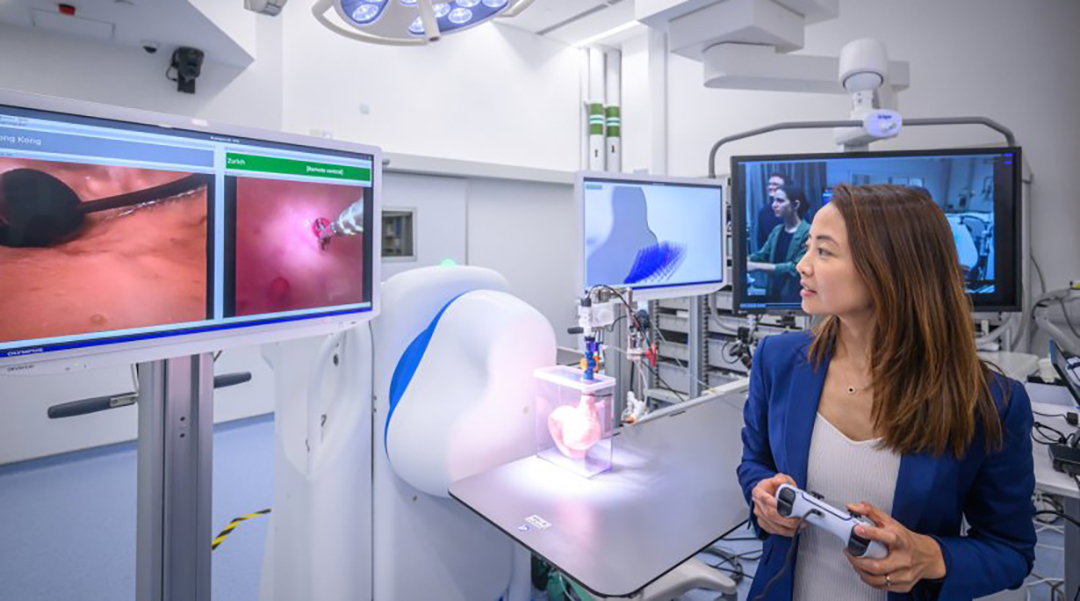A new remotely guided, magnetically steered robotic endoscope could make explorations deep within the human body safer, less invasive, and performable even in remote regions short on trained personnel.
An endoscopy is a test that looks inside the human body, along the gastrointestinal or digestive tract, using a long, thin tube with a small camera inside called an endoscope.
The National Institute of Health (NIH) estimates over 20 million gastrointestinal endoscopies are performed yearly in the US alone, and are used to diagnose anything from swallowing disorders and laryngitis, ulcers or polyps, and precancerous and cancerous tissues in the esophagus, stomach, duodenum, or colon.
Mastering conventional endoscopy requires years of specialized training, with surgeons needing significant practice and experience. Such expertise can be scarce, particularly in underserved areas, which affects the quality of care and access to these procedures in certain regions.
A new teleoperated robot
The answer to this could be teleoperated robotic surgery, a system in which a surgeon performs an operation remotely using a robot. This surgeon can be in the same room, across the hospital, or even on the other side of the world.
In a recent paper, published in the journal Advanced Intelligent Systems, scientists detail the first teleoperated endoscope that was used to operate a system in Hong Kong remotely from Zurich. The endoscope’s camera feed and the surgeon’s joystick commands, as well as other vital data, are transmitted over a secure internet connection, allowing for real-time control from a distance.
“Teleoperated surgery allows surgeons to work from anywhere in the world, making their expertise more accessible to patients, regardless of location. Robotic systems also enhance ergonomics, reduce the physical and mental demands on the surgeon, increase precision and safety, and can incorporate computer algorithms to assist the surgeon,” said Quentin Boehler, leader in medical robotics at the ETH Zurich’s Multi-Scale Robotics Lab. “Our approach, which uses magnetic fields, enables the design of smaller, more flexible endoscopes, potentially making procedures safer and less invasive for patients.”
Boehler added that the team’s system uses an endoscope equipped with a series of magnets along its length. By generating a magnetic field through a machine placed near the patient, surgeons can steer the endoscope inside the body.
“The surgeon controls the endoscope using joysticks, and a computer program translates these joystick movements into corresponding magnetic fields, which direct the endoscope as needed,” Boehler added.
Testing the robotic endoscope
The team began testing their system using synthetic models replicating the human gastrointestinal tract. These models closely replicate the visual and physical characteristics the team’s system would encounter in a real human body, including how the tissues behave when interacting with the endoscope.
After these tests helped the team refine the system’s design, software, and user interface, the researchers used it to perform an endoscopy on a sedated pig, selected because this animal’s gastrointestinal system closely resembles that of a human.
This procedure was performed in collaboration with researchers and veterinarians at the Multi-Scale Medical Robotics Center in Hong Kong, with the endoscope teleoperated almost 5,700 miles (9,300 kilometers) away.
“The operator in Zurich successfully navigated the magnetic endoscope within the pig’s stomach without any adverse events. The operator in Zurich experienced a delay of around 300 milliseconds, which was small enough to guarantee the safety and ergonomics of the procedure,” Boehler said.
“We successfully completed two tasks in which we were particularly interested. First, performing a U-turn or ‘retroflection’ with the endoscope and take a biopsy from the stomach wall. Both tests were successful, which makes us confident that we designed this system right.”
He added that the development of advanced systems like this one requires years of research and a massive collaborative effort.
“Having led the medical robotics activities at ETH Zurich’s Multi-Scale Robotics Lab since 2020, I’ve learned that creating cutting-edge technologies in medical robotics is about thinking out of the box and making new connections between robotics and unmet clinical needs,” Boehler said.
“One surprising aspect has been just how challenging it is to develop truly groundbreaking technologies, especially in medical robotics where both innovation and safety are critical.”
Transitioning to the clinic
Boehler explained that the next goal for the team is to perform a teleoperated endoscopy on a human patient. He added that the team believes this system has the potential to screen for cancer in the gastrointestinal tract.
Beyond this, Boehler and colleagues are also exploring the system’s use in other areas, such as neurovascular interventions and fetal surgery, where its flexibility and precision could be incredibly important, potentially transforming these areas of medicine.
“Expanding the range of procedures that can be performed remotely with our system will be crucial for widespread adoption of this approach. The treatment of time-critical conditions such as acute ischemic strokes would be particularly relevant,” Boehler said.
“A spin-off from our group, Nanoflex Robotics, is currently developing commercial systems based on our research to address these challenges. This is an exciting perspective to be able to translate this technology to the clinic,” he continued.
However, for teleoperated robotic surgery like this to become widespread, surgeons will need secure, reliable, and low-latency internet networks at both the robot’s and the surgeon’s locations. Boehler pointed out that although 5G coverage is expanding, infrastructure challenges, particularly in low- to middle-income countries, remain.
“I was struck by how much effort and time it takes to bring these concepts to a point where they are reliable and convincing to other stakeholders, like clinicians and investors,” Boehler concluded. “Despite the challenges, it’s incredibly rewarding to see the system perform as intended after overcoming so many technical and scientific obstacles.”
Reference: A. Mesot, M. Mattille, Q.Boehler, et al., Teleoperated Magnetic Endoscopy: A Case Study and Perspective, Advanced Intelligent Systems (2024) DOI: 10.1002/aisy.202400522
Feature image credit: The Chinese University of Hong Kong

















